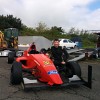OK - so what I've learned is ...
1) There are various web sites where you can turn Youtube into MP3 audio file.
(Obvious disclaimer: do not do this with *music* without checking for risk of digital rights infringement).
So you can easily get an MP3 audio file from dyno or in-car (on track NOK due to Doppler effect).
2) Dr. Matthias Mauch and Dixon at QMC, London (Centre for Digital Music) have developed A FUNDAMENTAL FREQUENCY ESTIMATOR USING PROBABILISTIC THRESHOLD DISTRIBUTION
It is called Probabalistic YIN or PYIN and there is a GNUware called TONY
Seems like clever stuff ...
http://matthiasmauch.de/_pdf/mauch_pyin_2014.pdf
You get TONY here:
https://code.soundsoftware.ac.uk/projects/tony/files
You just load in the MP3 and ... well play about a bit and you'll see.
I'm not certain its exactly what we require but it looks promising.
---------------------------------------------------------------------------------------------------------------------------------------------
The fundamental frequency it estimates is not always the engine order you expect and it can leave the odd gap (e.g. where the sound is weak) or throw in the odd octave "jump" but its pretty good.
I tested it on the Cosworth 20,000 rpm dyno engine video and it worked.
http://imgur.com/32pW2Fv
It will export the frequency/time data (called "pitch track data" - musical innit?) to a .csv file which is readable by Excel.
The data is real and therefore lumpy but this can be smoothed using the normal techniques, I guess.
The Hamilton at Monza soundtrack also works but I'm struggling to get the data to line up with the on-screen display data for rpm. Some of this could just be a time-shift due to the algorithm or lag in the telemetry display - but I have not really looked into it.
The jumps on this one are not Octave jumps by the algorithm they are gearshifts ...
http://imgur.com/bl33xHT

